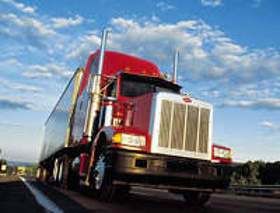Off Set Backing
Topic 13466 | Page 3

Offset is the spot next to you. And yes, hard right, hard left, then hard right again.

Offset is the spot next to you. And yes, hard right, hard left, then hard right again.
At my school the offset is to the right. I am a female so maybe I don't understand how to go the right way. Our offset is hard left, hard right. After that is my problem. When to understand my vehicle to react in order to bend.
Our trucks in class had a white marker at the halfway mark on the landing gear cross member. We would pull all the way up to the cone or whatever the perimeter is. Turn the wheel a turn and a half opposite of where you're headed of course. Then back until you see your marker or midway on the landing gear. Then cut hard the opposite direction until you see that side of the trailer in your mirror, driver side or blind. Then you basically chase the trailer, making SMALL adjustments until you can do a straight line into the spot. That's what I know.

At my school the offset is to the right. I am a female so maybe I don't understand how to go the right way. Our offset is hard left, hard right. After that is my problem. When to understand my vehicle to react in order to bend.
Ok, ours was to the left, so just reverse it... Hard left, hard right, hard left, then straight back. Nothing to do with gender.
Lynn has a problem:
After that is my problem. When to understand my vehicle to react in order to bend.
If you are wondering how long it takes from the time you turn the wheel until you can see the trailer start to bend, well, that is what all this practice is all about.
The trailer moves back about ten feet from the twist of the steering wheel till the tandems start to go in the new direction.
Look out the window at the tandems. Visualize farther back by ten feet. If you turn the steering wheel more towards the inside of the bend, backing ten feet will make more/tighter bend. Turn the wheel away from the bend, in ten feet backing the trailer will straighten out.
Tandems:
Tandem Axles
A set of axles spaced close together, legally defined as more than 40 and less than 96 inches apart by the USDOT. Drivers tend to refer to the tandem axles on their trailer as just "tandems". You might hear a driver say, "I'm 400 pounds overweight on my tandems", referring to his trailer tandems, not his tractor tandems. Tractor tandems are generally just referred to as "drives" which is short for "drive axles".
Tandem:
Tandem Axles
A set of axles spaced close together, legally defined as more than 40 and less than 96 inches apart by the USDOT. Drivers tend to refer to the tandem axles on their trailer as just "tandems". You might hear a driver say, "I'm 400 pounds overweight on my tandems", referring to his trailer tandems, not his tractor tandems. Tractor tandems are generally just referred to as "drives" which is short for "drive axles".
I don't believe being female has anything to do with it by the way.

We were taught: -hard right backing until we could see the opposite landing gear leg (under the trailer)in the driver's convex mirror, -then hard left backing until we could again see the opposite landing gear leg in the right convex mirror, which will put tandems just inside the lane -then another hard right and get under the trailer and -straight line back
(And it takes the trailer about ten feet to react.)
I too was taught this way at Swift Academy in Salt Lake City, Utah
Tandems:
Tandem Axles
A set of axles spaced close together, legally defined as more than 40 and less than 96 inches apart by the USDOT. Drivers tend to refer to the tandem axles on their trailer as just "tandems". You might hear a driver say, "I'm 400 pounds overweight on my tandems", referring to his trailer tandems, not his tractor tandems. Tractor tandems are generally just referred to as "drives" which is short for "drive axles".
Tandem:
Tandem Axles
A set of axles spaced close together, legally defined as more than 40 and less than 96 inches apart by the USDOT. Drivers tend to refer to the tandem axles on their trailer as just "tandems". You might hear a driver say, "I'm 400 pounds overweight on my tandems", referring to his trailer tandems, not his tractor tandems. Tractor tandems are generally just referred to as "drives" which is short for "drive axles".

I too was taught this way at Swift Academy in Salt Lake City, Utah
And it works everytime, first time.

Lynn has a problem:
After that is my problem. When to understand my vehicle to react in order to bend.
If you are wondering how long it takes from the time you turn the wheel until you can see the trailer start to bend, well, that is what all this practice is all about.
The trailer moves back about ten feet from the twist of the steering wheel till the tandems start to go in the new direction.
Look out the window at the tandems. Visualize farther back by ten feet. If you turn the steering wheel more towards the inside of the bend, backing ten feet will make more/tighter bend. Turn the wheel away from the bend, in ten feet backing the trailer will straighten out.
Thank you. I passed my test and did best on my offset. I finally found that the offset is more finesse then obsolete like the 90 or alley, which still needs some finesse too, but not as much.
Tandems:
Tandem Axles
A set of axles spaced close together, legally defined as more than 40 and less than 96 inches apart by the USDOT. Drivers tend to refer to the tandem axles on their trailer as just "tandems". You might hear a driver say, "I'm 400 pounds overweight on my tandems", referring to his trailer tandems, not his tractor tandems. Tractor tandems are generally just referred to as "drives" which is short for "drive axles".
Tandem:
Tandem Axles
A set of axles spaced close together, legally defined as more than 40 and less than 96 inches apart by the USDOT. Drivers tend to refer to the tandem axles on their trailer as just "tandems". You might hear a driver say, "I'm 400 pounds overweight on my tandems", referring to his trailer tandems, not his tractor tandems. Tractor tandems are generally just referred to as "drives" which is short for "drive axles".
New Reply:
New! Check out our help videos for a better understanding of our forum features

















Preview:
This topic has the following tags:
Advice For New Truck Drivers Tips For Backing







 TT On Facebook
TT On Facebook
Sorry not good with emoticons, or whatever they are. Love.....